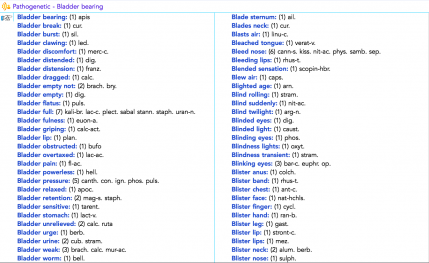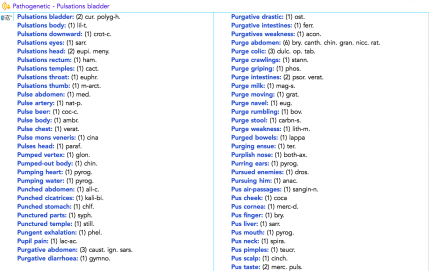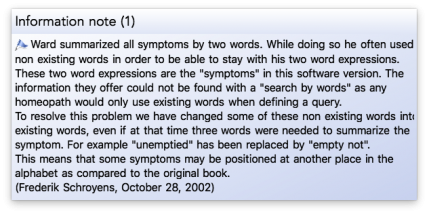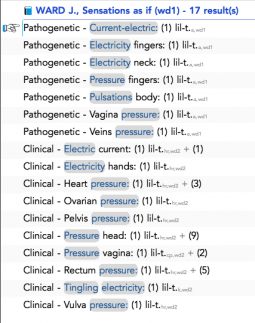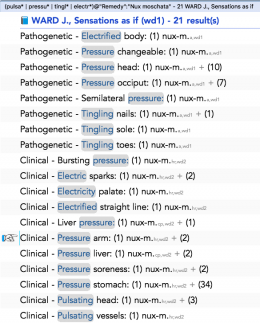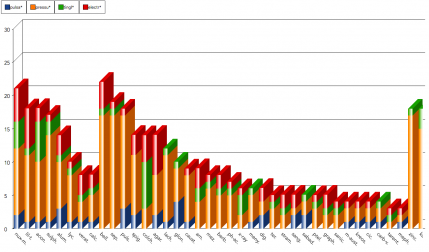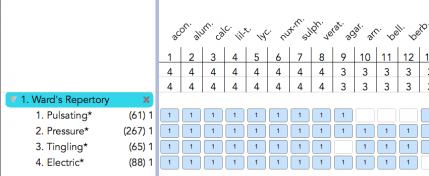Ward's "Sensations as if"
a repertory comprised of subjective symptoms written in a succint 2 word format
It is very helpful when studying remedies via "Reverse repertorisation" - extracting many hidden idiosyncrasies
Ward's "Sensations as if" becomes incredibly powerful when used in combination with RadarOpus software
- When a casetaking reveals intensely felt and well described sensations, particularly if they repeat in various parts of the body and mind, this repertory can be consulted (alongside Robert's Sensations as if).
- In RadarOpus, you can search for the main keyword of the sensation throughout Ward's Repertory, quickly extracting a Graphic Analysis of all the results.
- By combining multiple Search tabs, you can even build up a visual analysis of the main sensations expressed by the patient.
- For example: the words pulsating, pressure, tingling and electrical were searched (each in it's own search tab) to yield the following results:

- Each coloured segment in the column reflects one search tab:
- Blue for pulsating, Orange for pressure, Green for tingling, Red for electrical.
- By double clicking on a column, the search is performed again highlighting the chosen remedy.
- For example: the results in Nux moschata;

- Another example - Lilium tigrinum;

The preface of Ward's "Unabridged Dictionary of the Sensations as if" illuminates the purpose of this repertory
It is part of the puritan class (where proving language is preserved faithfully rather than converted into the language of the repertory)
-
The "Unabridged Dictionary of the Sensations as if" is another avenue of approach to the traditional problem of remedy selection from the vast Homoeopathic symptomatology
- Ward's "Sensations as if" is a repertory comprised of unique and characteristic symptoms found directly in the pathogenesis (provings) of many remedies - both well-known and lesser-known. These subjective sensations experienced in the process of provings or in the course of clinical experience, are generally expressed by the phrase "as if" or "as though."
- It was through painstaking research and examination of provings that these symptoms were collected from all Homoeopathic literature, beginning with the days of the illustrious Hahnemann and continuing methodically through the authoritative provings, writings and lectures of various esteemed authors.
-
Each rubric is comprised of 2 words to succintly describe the sensation
- In RadarOpus, you can also easily refer to the accompanying Materia Medica text to read the full proving / clinical symptom.
- For examnple, navigate to the rubric "Abdomen burst" in Ward's Repertory:

- To read the full proving symptom, open Ward's "Unabridged Dictionary of the Sensations as if" in Materia Medica:

-
The purpose of this dictionary is to increase the accessibility of symptomatic-descriptions expressed by the provers in the subjunctive mood and to record for clinical application the proved relationships between those symptoms and their remedies.
- Note - The subjunctive is a grammatical mood, a feature of the utterance that indicates the speaker's attitude toward it.
- Note - The subjunctive is a grammatical mood, a feature of the utterance that indicates the speaker's attitude toward it.
- Here is an example given by Ward to demonstrate the layout of the repertory:
- The full symptom;
- "Nails grey, dirty as if decayed; when cut scattering like powder and splitting into layers." will be found under the captions :
- Decayed Nails; Nails Dirty-Grey; Powdered Nails; Splitting Nails; Scattering Nails.
- Decayed Nails; Nails Dirty-Grey; Powdered Nails; Splitting Nails; Scattering Nails.
- "Nails grey, dirty as if decayed; when cut scattering like powder and splitting into layers." will be found under the captions :
- The full symptom;
-
The interview of the patient will naturally evoke in the Homeopath's mind the words most characteristic in their description.
- The art of Homeopathy is to translate the language of the patient into descriptive captions, thereby establishing a correlation between the salient words of the patient and captions of proved and clinical symptoms.
- The elaborate symptomatic expressions as shown in this volume should convince the reader of the variety of sensations experienced and often extravagant language used by provers.
- The apparent trivialities in the peculiar "symptom expressions" are the recorded words of the provers and comparable to the descriptions given by the patients in our every-day practice.
-
The Pathogenetic or first division of the book comprises a summary and thorough research of the original provings as found in Timothy F. Allen's "Encyclopedia of Pure Materia Medica."
- Wherever Hahnemann has written in his Materia Medica Pura or in the Chronic Diseases symptom-descriptions embracing the words "as if" they have been given priority by the author and substituted for similar sensation-symptoms found elsewhere.
- Wherever Hahnemann has written in his Materia Medica Pura or in the Chronic Diseases symptom-descriptions embracing the words "as if" they have been given priority by the author and substituted for similar sensation-symptoms found elsewhere.
-
The next in order of appropriation were symptoms recorded in John H. Clark's Dictionary of Materia Medica, which included many provings since 1880 not to be found in Allen's Encyclopedia.
- In this part of the book were also collected symptom-descriptions of provings widely distributed throughout the Journals: Transactions of the American Institute of Homoeopathy, The Proceedings of the International Hahnemannian Association, and extensive English Literature of the Homoeopathic school as is attested by the Bibliography.
- In this part of the book were also collected symptom-descriptions of provings widely distributed throughout the Journals: Transactions of the American Institute of Homoeopathy, The Proceedings of the International Hahnemannian Association, and extensive English Literature of the Homoeopathic school as is attested by the Bibliography.
-
The Clinical section of the Repertory & Materia Medica is a record of verifications developed through clinical experience and observation of many distinguished contributors to the symptomatology of our Materia Medica.
- The "Guiding Symptoms" of the stalwart American Homoeopath, Constantine Hering, have been made the basic record of this part of the book, although writings, lectures and records of others have contributed to the fulness of it.

